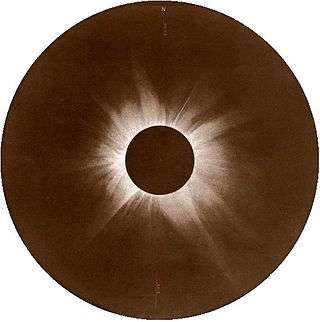Solar eclipse of January 3, 1908
| Solar eclipse of January 3, 1908 | |
|---|---|
 Map | |
| Type of eclipse | |
| Nature | Total |
| Gamma | 0.1934 |
| Magnitude | 1.0437 |
| Maximum eclipse | |
| Duration | 254 sec (4 m 14 s) |
| Coordinates | 11°48′S 145°06′W / 11.8°S 145.1°W |
| Max. width of band | 149 km (93 mi) |
| Times (UTC) | |
| Greatest eclipse | 21:45:22 |
| References | |
| Saros | 130 (46 of 73) |
| Catalog # (SE5000) | 9299 |
A total solar eclipse occurred on January 3, 1908. A solar eclipse occurs when the Moon passes between Earth and the Sun, thereby totally or partly obscuring the image of the Sun for a viewer on Earth. A total solar eclipse occurs when the Moon's apparent diameter is larger than the Sun's, blocking all direct sunlight, turning day into darkness. Totality occurs in a narrow path across Earth's surface, with the partial solar eclipse visible over a surrounding region thousands of kilometres wide.
Observations
The eclipse was observed by astronomer William Wallace Campbell of Lick Observatory, viewed from Flint Island, Kiribati:[1]
Related eclipses
Solar eclipses 1906-1909
Each member in a semester series of solar eclipses repeats approximately every 177 days and 4 hours (a semester) at alternating nodes of the Moon's orbit.
| Ascending node | Descending node | |||
|---|---|---|---|---|
| 115 | July 21, 1906 Partial |
120 | January 14, 1907 Total | |
| 125 | July 10, 1907 Annular |
130 | January 3, 1908 Total | |
| 135 | June 28, 1908 Annular |
140 | December 23, 1908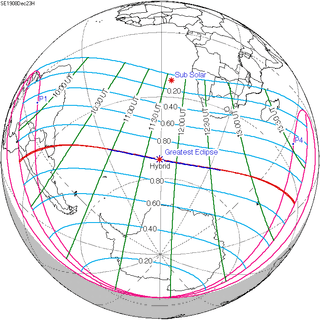 Hybrid | |
| 145 | June 17, 1909 Hybrid |
150 | December 12, 1909 Partial | |
Saros 130
It is a part of Saros cycle 130, repeating every 18 years, 11 days, containing 73 events. The series started with partial solar eclipse on August 20, 1096. It contains total eclipses from April 5, 1475 through July 18, 2232. The series ends at member 73 as a partial eclipse on October 25, 2394. The longest duration of totality was 6 minutes, 41 seconds on July 11, 1619.[2]
| Series members 43–56 between 1853 and 2100 | ||
|---|---|---|
| 43 | 44 | 45 |
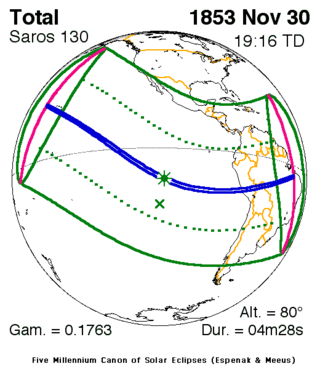 November 30, 1853 |
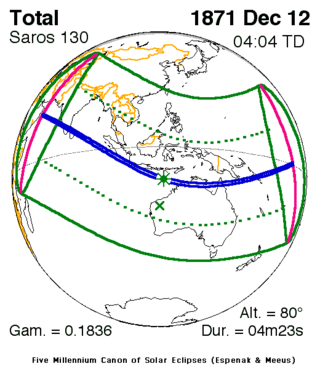 December 12, 1871 |
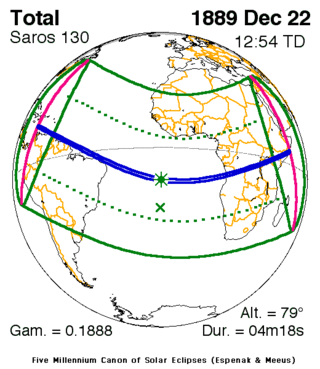 December 22, 1889 |
| 46 | 47 | 48 |
 January 3, 1908 |
 January 14, 1926 |
 January 25, 1944 |
| 49 | 50 | 51 |
 February 5, 1962 |
 February 16, 1980 |
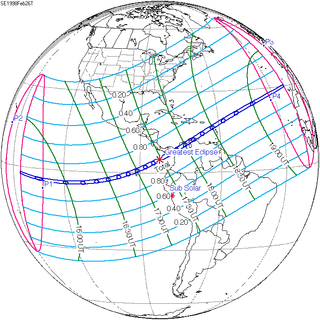 February 26, 1998 |
| 52 | 53 | 54 |
 March 9, 2016 |
 March 20, 2034 |
 March 30, 2052 |
| 55 | 56 | |
 April 11, 2070 |
 April 21, 2088 | |
Notes
- ↑ Powerhouse Museum. "Solar Eclipse, Flint Island, Kiribati, 1908". Powerhouse Museum, Australia. Retrieved 11 March 2016.
- ↑ "Saros Series catalog of solar eclipses". NASA.
References
- Earth visibility chart and eclipse statistics Eclipse Predictions by Fred Espenak, NASA/GSFC
- Photo of Solar Corona January 3, 1908
| Wikimedia Commons has media related to Solar eclipse of 1908 January 3. |
